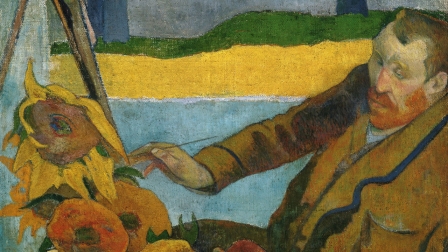The Three Types Of Relationship Every Creative Person Needs
“My only anxiety,” a young Vincent van Gogh wrote in desperation, “is how can I be of use in the world?”
From the despair of a failed missionary outpost, he was pleading for direction from his older brother Theo, the person he always went to with his problems. Once again at his wit’s end and on the verge of failure, Van Gogh was struggling to make sense of his life.
Vincent’s parents, along with just about everyone else in his life, were wondering when he was going to make something of himself. He may have been wondering that, too. And here was Theo, writing back and enclosing some money—bailing him out once again.
What happened next changed the history of art. The young Van Gogh didn’t quit. Starting with drawing, then moving to painting, Vincent dedicated the next decade of his life to art. From roughly this point forward, he pushed forward at an incredible pace, averaging at least a painting a day, churning out thousands of artworks—a lifetime’s worth of achievements in a fraction of the time. And he did it with the support of his brother.
Contrary to popular belief, Vincent van Gogh did sell more than a single painting in his lifetime. He just sold most of them to Theo, his de facto patron. Their partnership made the spread of Vincent’s work possible. Sure, Theo was his brother, but, more important, he was a well-connected art dealer who believed in a promising painter.
One thing many of us tend to forget today is that we don’t often get a Vincent van Gogh without a Theo van Gogh.
It was Theo who prompted Vincent to move to Paris and introduced him to a group of misfit painters called “Impressionists.” And it was Theo who supported his brother’s work when no one else understood it, along with Theo’s wife Johanna, who would champion it long after both Van Gogh brothers were dead and gone.
Putting Our Heads Together
We all want to believe that if our work is good enough, we’ll be recognized for our creative genius. Whether as artists, entrepreneurs, or employees, we believe success is mostly a meritocracy. It isn’t. Who you know matters, and without the right connections, even the best work won’t get noticed.
But this isn’t just about the importance of networking—it goes straight to the heart of the creative process. We’re often led to believe that creative minds toil alone in a cabin in the woods or stuffed away in some laboratory, too busy to be bothered.
“You might wonder,” creativity expert Keith Sawyer wrote in his book Group Genius, “Isn’t the individual mind the ultimate source of creativity? Doesn’t each creative spark come from a single person?”
Not exactly, says Sawyer. Creativity is always the result of collaboration, whether it’s intentional or not. In my study of successful creatives today, I’ve identified three kinds of collaboration that every creative person needs in order for their work to succeed and influence others.
1. A Scene
Where we live and do our work matters. We understand intuitively that some places have greater concentrations of a certain kind of person than others. A huge number of musicians move to my hometown, Nashville, every year in hopes of making it big in the music industry. Same goes for actors moving to Hollywood and artists relocating to Brooklyn.
The work of urban studies theorist Richard Florida underscores this phenomenon. “The most important factor in the success of your career,” he tells me, “is where you decide to live.” According to Florida, who has indexed the most creative cities in America and regularly measures where the “creative classes” call home, not all places are created equal.
Each locale has a personality that can be instrumental in the success or failure of a person’s work; you need to find the right fit for what you do. Certain scenes can be hotbeds for certain kinds of creative output, as Silicon Valley is for computer programmers or 1850s Paris was for visual artists.
The scenes we join (or fail to) unavoidably affect the success of our work. And sometimes the best career move is to physically move. Go someplace where something’s happening that relates to your creative passion, even if you do that on a small scale at first—like by attending a conference or even just moving across the room to engage in a scene that’s already taking place.
2. A Network
Everyone needs a network, and creatives are no exception to this rule. In fact, the “it’s who you know” rule seems to apply even more so to artists. Since art—or any creative craft, really—is inherently subjective, the opinions of a handful of important people can be hugely important.
“You really only need one or two good friends,” New York–based artist Hank Willis Thomas told me, “because it’s really about having someone who’s going to advocate for you. That’s the formula for success.”
What is a network, exactly, and how is building one different from joining a scene? A network is a little bit looser and more relational—it’s an informal group of people who come together for the purpose of connecting with each other. Networks tend to stretch beyond the borders of a given scene; members may not all know one another personally, but they’re each influential to the success of the network itself.
Networks don’t just happen, though. You often have to look for them, making use of the people already around you, and constantly curating your relationships in hopes of strengthening the network. Success doesn’t take an army, but it does take a small group of people who can help your work get the attention it deserves.
This isn’t about getting your big break, though; it’s just about being good enough to make it and knowing the right people who can help you get there. Every thriving artist understands the power of networks, whereas every starving artist continues to try and make it on their own.
3. A Community
“There was a group of them, 19 men, and they got together once or twice a week for about 17 years. And in those meetings there was a special kind of magic that happened,” Diana Glyer, author and English professor at Azusa Pacific University, explained to me recently. Glyer is an expert on the literary group known as the Inklings, which included C.S. Lewis, J.R.R. Tolkien, and others.
“They read their works-in-progress to one another, and they stayed up late into the night giving each other critiques,” Glyer says. “And it is in this forge of friendship and engagement that some of the great works that we love were created”—including The Chronicles of Narnia and The Lord of the Rings.
These works, Glyer has found, didn’t result from any single act of genius, but rather creative collaboration—and of a very specific kind. The Inklings got together to collaborate intentionally, spurring each other on and even challenging one another to do better.
We all need groups of people not just to connect with, but with whom we can share our work—people Glyer calls “resonators,” those who affirm when you’re on the right track and guide you back when you’re not. This type of collaborative interaction is arguably the hardest to secure. It’s more deliberate and tighter-knit than either a scene or a network, but it’s no less crucial. And we often build creative communities out of people we meet in those other two.
Without a community, our best work will stay stuck inside us. We need peer groups and circles of influence to make our work better. This is true in art, but it’s also true in business. Any work that requires you to make something the world hasn’t seen before is work that often has to be done collaboratively.
This is ultimately good news. If you have a powerful idea, you aren’t solely on the hook for pulling it off all by yourself. If you’re feeling stuck, it may be that your creativity simply needs fuel and support from your relationships. It might be time to stop trying to force the creative process and instead start going out there and interacting with people—locating the right scene, growing your network, and building a community.
When you’re hitting a wall creatively, ask yourself:
- Am I part of a powerful scene that connects me to others who can help me grow and succeed?
- Have I established lasting connections with people who can help me and whom I can help?
- Is there a group that I meet with regularly that challenges me and calls out the best in me?
This is how great creative work gets made—not in isolation, but through everyday collaboration. It was true for Vincent van Gogh, and it’s true for us today.
Jeff Goins is a writer who lives in Nashville, Tennessee, with his family. He is the author of the national best seller The Art of Work: A Proven Path to Discovering What You Were Meant to Do. Follow him on Twitter at @JeffGoins.
Fast Company , Read Full Story
(30)











